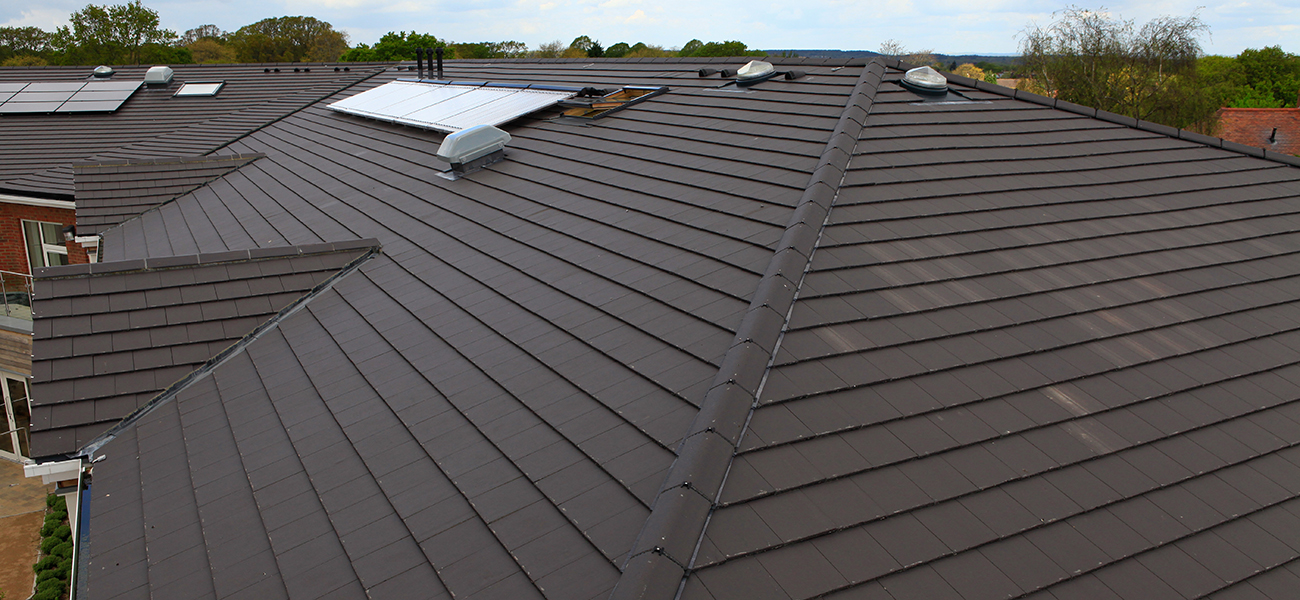What is efflorescence and is it permanent?


The term “efflorescence” encompasses a range of phenomena, and various forms can occur. The deposits found on different materials vary significantly in chemical composition and method of formation. The processes which give rise to efflorescence in clay products, for example, are different to those that affect concrete.
In this post, we will explain what efflorescence is, why it occurs on roof tiles, how long it lasts, how to remove it and how it can be prevented.
Efflorescence: Why are there white marks on my concrete roof tiles?
On concrete roof tiles, efflorescence often appears as white patches or a subtle lightening of the tile colour. This is often referred to as lime bloom and is caused by compounds present in the concrete migrating to the surface.Faye Ratcliffe, technical advisor at Marley, explains: “During production and the early stages of the roof tile's life, calcium hydroxide forms within the tile. When moisture moves through the concrete, it can travel to the surface of the roof tile, where it appears as a white haze.”
Primary efflorescence typically occurs within the first few days or weeks after installation, while secondary efflorescence may develop later if external moisture sources, such as rain or snow, continue to dissolve the compounds within the tile and draw them to the surface.
Efflorescence can sometimes be mistaken for fading or washing out of the concrete colour, but it is temporary and purely superficial.
Why does efflorescence appear on concrete roof tiles?
Efflorescence is a natural result of the reaction between cement and water. During curing, calcium hydroxide forms within the tile and is slightly soluble in water. When the tile becomes wet, the calcium hydroxide can move to the surface.
Faye explains: “Under certain conditions, the calcium hydroxide can migrate through the concrete to the surface. Over time, it may react with carbon dioxide in the atmosphere to produce calcium carbonate crystals.” Calcium carbonate is less soluble, making the white deposits more persistent.
“This is why you sometimes see the marks for several months. However, they are usually very thin and become transparent when wet – and will weather away over time,” Faye says.
The occurrence of lime bloom on concrete roof tiles is erratic and unpredictable, but wet weather conditions can be a significant factor.
Efflorescence forms more readily when the concrete tile becomes wet and dries slowly and therefore occurs more often during winter. If, prior to installation, roof tiles are stored in damp conditions or on the ground, they may absorb excess moisture and later show signs of efflorescence.
“It is generally only likely to occur in the early life of the roof tile, so materials installed for a year or more without experiencing lime bloom are unlikely to be affected in the future,” she explains.
She also warns that the sudden appearance of efflorescence in an established roof could be a sign of underlying problems: “Since efflorescence is usually only an issue in the first year or so of a roof tile’s life, its appearance in a more established roof could indicate that the roof is experiencing excessive moisture penetration, leaks or drainage issues. Homeowners noticing this should have the roof inspected to ensure there are no underlying problems affecting the tile or roof structure.”
How long does efflorescence last in roof tiles?
The duration of efflorescence effects will depend on the amount of calcium hydroxide deposits, as well as local weather and atmospheric conditions.The deposits on the roof tile surface usually disappear within 6–12 months and will not recur.
How to remove efflorescence from concrete roof tiles
Efflorescence is removed by natural weathering processes.
- Since rainwater is slightly acidic, it gradually dissolves and washes away the calcium carbonate over several months.
- In warm, dry weather, the deposit may also be blown away.
“It is impossible to state precisely how long efflorescence will take to be removed by the weather, but once the tiles have matured, efflorescence typically doesn’t recur,” Faye adds.
While it is possible to remove efflorescence with diluted vinegar or a brush, it's also important to remember that it's a temporary deposit that will go away over time.
Faye urges against trying to remove efflorescence from concrete roof tiles manually. “Working at height to clean roof tiles can be dangerous, and you risk damaging the roof tiles in the process. Let the natural cleaning cycle do the job for you.”
She adds: “If you must clean the tiles, avoid harsh chemicals and never use a high-pressure washer, as it can damage the surface of the roof tiles, dislodge mortar or fixings and force water under the tiles.”
Does efflorescence damage roof tiles?
No. Efflorescence is cosmetic only and does not affect the strength, durability, weatherproofing or lifespan of concrete roof tiles.After the efflorescence is cleared, the original true colour of the roof tiles will return, and the colour consistency will be unaffected.
Preventing efflorescence on Marley concrete roof tiles
Marley concrete roof tiles have a pigmented polymer surface coating to help suppress the formation of efflorescence compounds. This coating has a lifespan of three to five years. By the time this coating has weathered, the concrete tile will have matured to such an extent that it is no longer susceptible to efflorescence.
If you notice white deposits on your roof tiles and are unsure whether it’s efflorescence or another issue, Marley roofing experts can provide guidance. Our team can help identify the cause and reassure you about the durability and appearance of your roof.
To speak with one of our roofing experts about any concerns you may have with your roof, please contact a member of our team.
Disclaimer - The information shared in this blog is correct at the time of publication. Guidance, standards, and best practices may change over time, so if you’d like further clarification or the latest updates, please get in touch with the Marley Technical Advisory Team, who will be happy to help.